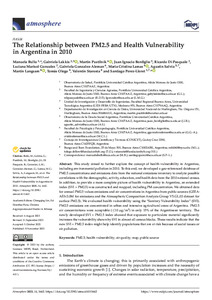Por favor, use este identificador para citar o enlazar este ítem:
https://repositorio.uca.edu.ar/handle/123456789/17440| Título: | The relationship between pm2.5 and health vulnerability in Argentina in 2010 | Autor: | Bullo, Manuela Lakkis, Susan Gabriela Pustilnik, Martin Bonfiglio, Juan Ignacio Di Pasquale, Ricardo Héctor Gonzalez, Luciana Marisol Gonzalez Aleman, Gabriela Lamas, María Cristina Salvia, Agustín Langsam, Martín Olego, Tomás Starosta, Valentín Pérez Lloret, Santiago |
Palabras clave: | CONTAMINACION AMBIENTAL; PM2,5; VULNERABILIDAD SANITARIA; CALIDAD DEL AIRE | Fecha de publicación: | 2023 | Editorial: | MDPI | Cita: | Bullo, M. et al. The relationship between pm2.5 and health vulnerability in Argentina in 2010 [en línea]. Atmosphere. 2023, 14(11) 1662. doi: 10.3390/atmos14111662. Disponible en: https://repositorio.uca.edu.ar/handle/123456789/17440 | Resumen: | Abstract: This study aimed to further explore the concept of health vulnerability in Argentina, including environmental pollution in 2010. To this end, we developed a geo-referenced database of PM2.5 concentrations and emissions data from the national emissions inventory to analyze possible correlations with the demographic, activity, education, and health data from the 2010 national census. In addition, to provide a more complete picture of health vulnerability in Argentina, an extended index (SVI + PM2.5) was constructed and mapped, including PM concentration. We obtained data for annual PM2.5 values emissions and air concentrations in Argentina from public sources (GEEAAEIv3.0M for emissions and the Atmospheric Composition Analysis Group V5.GL.03 dataset for surface PM2.5). We evaluated health vulnerability using the “Sanitary Vulnerability Index” (SVI). PM2.5 emissions are concentrated in urban and intensive agricultural areas of Argentina. PM2.5 air concentrations were acceptable (≤10 µg/m3 ) in only 15% of the Argentinean territory. The newly developed SVI + PM2.5 index showed that exposure to particulate material significantly increases the vulnerability shown by SVI in almost all census blocks. These results indicate that the new SVI + PM2.5 index might help identify populations that are at risk because of social issues or air pollution. | Cobertura Espacial: | Argentina | Cobertura Temporal: | Siglo XXI | URI: | https://repositorio.uca.edu.ar/handle/123456789/17440 | ISSN: | 2073-4433 (online) | Disciplina: | INGENIERIA AMBIENTAL | DOI: | 10.3390/atmos14111662 | Derechos: | Acceso abierto | Fuente: | Atmosphere. Vol.14, No.11, 1662, 2023 |
| Aparece en las colecciones: | Artículos |
Ficheros en este ítem:
| Fichero | Descripción | Tamaño | Formato | |
|---|---|---|---|---|
| relationship-between-PM2.5.pdf | 4,12 MB | Adobe PDF |  Visualizar/Abrir |
Visualizaciones de página(s)
51
comprobado en 27-abr-2024
Descarga(s)
29
comprobado en 27-abr-2024
Google ScholarTM
Ver en Google Scholar
Altmetric
Altmetric
Este ítem está sujeto a una Licencia Creative Commons

